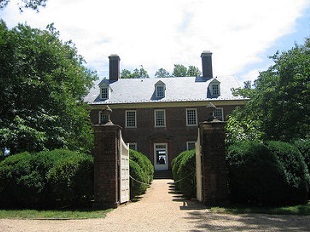
Courtesy of Jean-Pierre Louis
Berkeley Hundred
In 1618, Sir William Throckmorton, Sir George Yeardley, George Thorpe, Richard Berkeley, and John Smyth of Nibley received a land grant from the Virginia Company of London. The land grant was for eight thousand acres on the north bank of the James River near Herring Creek. The settlement was 20 miles upstream from Jamestown.
In 1619, thirty-eight passengers sailed on the Margaret from Bristol, England to settle the new Town and Hundred of Berkeley. Arriving on December 4, 1619, the settlers had the first "Thanksgiving", a tradition that was established two years before the Pilgrims landed at Plymouth Rock.
In March 1622, Chief Opechancanough led a series of coordinated attacks against the colonists. Known as the Indian Massacre of 1622, the attacks claimed the lives of nine colonists at Berkeley Hundred. For several years after the attack, Berkeley Hundred was abandoned. In 1636, William Tucker and others took possession of the property. By this time the area had become a part of Charles City Sire, which was later renamed Charles City County. The property was inherited by Giles Bland, the son of John Bland who took possession of the property in 1636. Giles Bland was hung by Governor William Berkeley in 1676 after participating in Bacon's Rebellion. The property was then purchased by Benjamin Harrison (1673-1710). Harrison served as the attorney general of the colony and as treasurer and speaker of the House of Burgesses. He died at the age of 37 in 1710, and left the property to his only son, Benjamin.
Berkeley Plantation
In 1726, Benjamin Harrison IV built a three story brick mansion on a hill overlooking the James River. The bricks were fired on the plantation. That same year, Benjamin Harrison V, the future signer of the Declaration of Independence, was born at the family seat. Harrison V attended the College of William and Mary but did not graduate due to the death of his father, Harrison IV, in 1745. Shortly after Harrison V married Elizabeth Basset. In 1749, Harrison V was elected to the House of Burgesses and served until 1755. He also served as a delegate to the Continental Congress from 1774 to October 1777. He was a member of the Virginia conventions of 1775 and 1776 and the House of Delegates from 1776-1781 and 1784-1791. Harrison V was elected governor of Virginia in November 1781 and was reelected twice. Harrison V died on April 24, 1791 and was buried in the family cemetery near the brick home.
In 1781, Benedict Arnold looted Berkeley Plantation. Sometime between 1790 and 1800, the mansion was architecturally altered from a Georgian style to an Adam style. By 1862, Berkeley Plantation was known as Harrison's Landing. It regained its prominence after the Union Army withdrew from the Potomac River following the Battle of Malvern Hill. The plantation served as a supply center from the Union Army. While stationed at Berkeley, General Daniel Butterfield created Taps, one of the most recognized and revered bugle calls in the nation. It was originally meant as a tranquil signal to extinguish the camp lights, but it developed into a solemn tribute to honor the sacrifice and service of the nation's fallen.
Berkeley Plantation is also the birthplace of President William Henry Harrison (1773-1841).
The site was listed on the National Register of Historic Places on April 13, 1972. For more information about the plantation's history and visting, please call: 888-466-6018 or visit BerkeleyPlantation.com
Last updated: September 30, 2025
